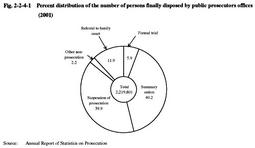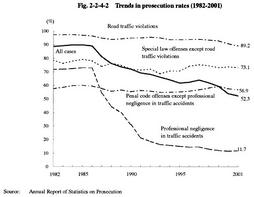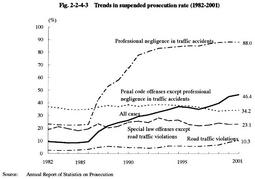| Previous Next Index Image Index Year Selection | |
|
|
Fig. 2-2-4-1 shows the percent distribution of the number of persons finally disposed by public prosecutors offices in 2001.
Fig. 2-2-4-1 Percent distribution of the number of persons finally disposed by public prosecutors offices (2001) In 2001, 130,038 persons (5.9% of the total) were prosecuted for formal trials, 892,613 (40.2%) were prosecuted for summary orders, 885,085 (39.9%) were granted suspension of prosecution, 47,744 (2.2%) were not prosecuted for other reasons, and 264,321 (11.9%) were referred to family courts ( Appendix 2-1 ).Fig. 2-2-4-2 and Fig. 2-2-4-3 show the trends in the prosecution rate and the suspended prosecution rate over the last 20 years from 1982, by type of offense. The prosecution rate was 52.3% (down by 1.6 points from the previous year) and the suspended prosecution rate was 46.4% (up by 1.5 points from the previous year) of all cases in 2001. Since 1987, the prosecution rate of professional negligence in traffic accidents has been decreasing (see Part 1, Chapter 1, Section 3 ). With respect to penal code offenses other than professional negligence in traffic accidents, the prosecution rate and the suspended prosecution rate have been within the range of 50% or over but below 60% and within the range of 30% or over but below 40% respectively (see Appendix 2-3 ). Fig. 2-2-4-2 Trends in prosecution rates (1982-2001) Fig. 2-2-4-3 Trends in suspended prosecution rate (1982-2001) Table 2-2-4-4 shows the number of suspects who were not prosecuted for offenses excluding professional negligence in traffic accidents and road traffic violations over the last 10 years, by reason for non-prosecution. In 2001, the number of suspects who were not prosecuted on the grounds of being granted suspension of prosecution increased by 4,617 from the previous year and accounted for 71.8% of the total while the number of suspects who were not prosecuted on the grounds of being insane decreased by 80 (16.7%) from the previous year to 400 (0.4% of the total).Table 2-2-4-4 Persons subject to non-prosecution disposition, by reason (1992-2001) Explanation of termsConcept of monopolization of prosecutions: Under this concept, the authority to prosecute is exclusively granted to public prosecutors. Quasi-prosecution procedure: Under this system, in the case where the public prosecutor decides not to prosecute the suspect, if the complainant or accuser who is dissatisfied with the non-prosecution disposition files an application with a court to commit a case for trial, the court shall decide to commit the case for trial when the court considers the application as appropriate, and thereby a prosecution is deemed to be instituted. This system is also called system of application to commit a case to a court for trial. |



